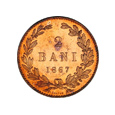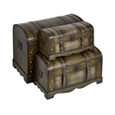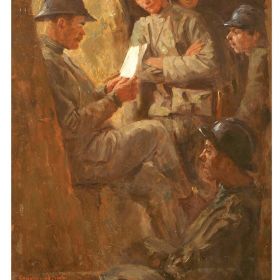Artists and World War I
Text: Oana Ilie / foto: Marius Amarie
Artists could not remain insensitive to the world war that broke out in 1914. Although not all of them took part in the war as combatants, the war became for many of them a topic they could no longer ignore. Thus, many undisputably valuable literary or artistic works were inspired by the Great War.
After some of the plastic artists were mobilized and fought during 1916, a group of painters and sculptors was organized for documenting the war in the summer of 1917. As a result of the Circular no. 9400/ 23 June 1917, the artists were directly attached to the General Headquarters, the 3rd Section and their works were going to lay the foundations of a future military museum. Out of the plastic artists that formed this group, we mention the sculptors Ion Jalea, Cornel Medrea, Oscar Han, Dimitrie Mățăuanu and the painters D. Stoica, I. Theodorescu-Sion, Ștefan Dimitrescu, Camil Ressu, Nicolae Dărăscu, etc. However, their activity lasted for only a few months; in September 1917 a first close-circuit exhibition was opened, whereas in January 1918 the first public exhibition with their works was organized.
A new way to see art (and, certainly, the war, which played a very important part) made the artists who were in Iași during the war and who had works at the exhibition organized by the General Headquarters in 1917 lay the foundations of a new association, “The Romanian Art”, one year later.
One of the most prolific painters of the Great War is Ion Stoica Dumitrescu, known as D. Stoica (the name he used for signing his artistic creations). Besides the dimension of the global conflagration and the changes it brought to people’s life and mentality at the beginning of the previous century, Stoica Dumitrescu’s choice of subjects was greatly influenced by his orientation towards historical painting. He will preserve this orientation for his entire career, many of his works having a historical theme: Michael the Brave’s Triumphant Entrance in Alba Iulia, The Oak from Borzești, Cuza and Moș Ion Roată, or The Battles in Mărășești, During the refuge etc.
The first global conflagration was not the first war in which Ion Stoica Dumitrescu took part. He had previously participated in the Second Balkan War, in the campaign in Bulgaria in the summer of 1913. When Romania entered the war, D. Stoica was 30 years old and he was famous in the artistic world. He organized his first exhibition in 1915, he was the illustrator of the “Neamul românesc” publication, and Nicolae Iorga had dedicated an article to him in the “Ramuri” magazine.
He was wounded for three times in the fights at Turtucaia, but went back to the warfront, in order to take part in the battles in Moldavia, first as a serviceman and then as a painter of the General Headquarters. That was the time when he became Mihail Sadoveanu’s friend. He started the war as a sergeant and finished it as a lieutenant. He had both fought and painted up to the summer of 1917, when he became a war reporter, authorized to draw sketches both on the warfront and behind the lines. Thus, he immortalized both faces of soldiers and aspects of the war – fights, camps, refugees. Many of these works were donated to the National Military Museum, among whose founders there was the Museum of War in Paris. Some of the works about the war were selected for the exhibition organized in Iași in 1917.
Although many of Stoica Dumitresc’s artworks are on display at the “Ferdinand I” National Military Museum (where he was employed as a painter and restorer), the collection on the subject of World War I at the National Museum of Romanian History cannot be ignored.
The banishment of the Germans (lithograph on paper; 54x70 cm; signed and dated, lithographed, on the lower left side: Stoica D. 1917; on the lower left edge, in pencil: [.?.] Stoica D. Iaşi April 18; inv. 2143.
The last prayer (lithograph on paper; 55x78 cm; signed and dated on the lower left side, in black pencil: Stoica D 917; an autograph inscription, signed and dated on the lower left edge, in pencil: to Colonel Ioanide [?] / Stoica D. 917 Iasi 18 April; inv. 2144).
The exile, (easel graphic; 53.5 x 88.5 cm; signed and dated on the lower right side, in pencil: Stoica D. 917; inv. 2145).
The last assault of the wounded bugler (easel graphic; 53 x 86 cm; signed and dated on the lower right side, in pencil: Stoica D. 917/ Iasi; inv. 2146).
During the refuge (easel painting; 43 x 80 cm; signed on the lower left side, in brown: Stoica; inv. 101793).
Battle scene (easel painting; 67 x 54 cm signed on the lower right side, in black: Stoica D.; inv. 127022).
Battle scene from World War I (easel painting; 55 x 46 cm; signed on the lower right side, in black: Stoica D.; inv. 315342).
Battle scene from World War I (easel painting; 59 x 48,5 cm; signed on the lower right side, in red: Stoica 19; inv. 315595).
Ion Bărbulescu alias B’Arg is one of the painters who had a first-hand experience of the war’s horrors. He was concentrated and then mobilized at the 10th Regiment Putna Focșani. During 1917, he was in Iași and later he was employed by the Army’s Arsenal, in the group of “plastic artists”. Besides painting, during his stay in Iași, Ion Bărbulescu was a collaborator of various publications in Iași: “România”, “Arena”, “Dușmanul” etc.
The artworks created during the war were gathered in an author exhibition, which was praised by the critics of the epoch. Among the subjects of his paintings, we notice: the hard winter of 1917 in Iași, the hospitals, the refugees, the prisoners, the graveyards, etc. His painting has a double value: both artwork and historical document. George Ciprian used to say about him: “He is a specific personality, the master of a unique technique, who cannot be compared to any other artist but himself”.
The plastic art collection of the National Museum of Romanian History owns three artworks by B’Arg on the theme of the war.
The ruins of the sugar factory at Mărăşeşti (easel painting; 31 x 52.5 cm; signed and dated on the lower right side, in brown: I. Barbulescu / 917, inv. 52927).
A soldier reading a letter in the shelter at Mărăşeşti (easel painting; 29.5 x 47 cm; signed and dated on the lower right side, in yellow: I. Bărbulescu / 917, inv. 52928).
Battle scene from World War I (easel painting; 61.5 x 88 cm; signed and dated on the lower right side, in pink: I. Bărbulescu 1917; inv. 116726).
Nicolae Tonitza had not only been mobilized since the very beginning of the war within the 84th Regiment of Infantry, but he was also a prisoner in the camp of Kirjali (Bulgaria) after the battles of Turtucaia (1 – 6 September 1916). During his stay in the camp, he painted almost continuously, finding his inspiration in nature and in the suffering caused by the war, but many of his works from that period have not been preserved. He took part in the exhibition The Romanian Art in Iași in 1918, and, in 1921, he had an exhibition together with two other former combatants: Ștefan Dimitrescu and Camil Ressu.
Out of Tonitza’s artworks, the National Museum of Romanian History has on display:
Prisoners in the camp (easel painting; 87 x 65 cm; signed on the lower right side, in ochre: N. TONITZA; inv. 144940).
The prisoners’ convoy (easel painting; 99 x 59,4 cm; signed on the lower right side, in brown: N. TONITZA; inv. 144941).
From Camil Ressu, who was going to lead the new artistic association founded in Iași at the end of the war, the National Museum of Romanian History has on display only one painting from that period, as well as a group photograph, where we can see Ressu together with other officer painters and sculptors (identified Oscar Han). 150666.
Soldiers in 1918 (easel painting; 47 x 58.7 cm; signed on the lower right side, in black Indian ink: C. Ressu; inv. 101792).
Ion Theodorescu-Sion also took part in World War I, being one of the painters mobilized to the General Headquarters. Zambaccian used to say that he had found him in Cernavodă in 1916, “both of them being reserve officers”, but, after the withdrawal, his unit went to Oituz, whereas Sion “went to Iași, mobilized by the General Headquarters”. They were to meet again during 1917 in Iași, where Sion, as an artillery reserve lieutenant, “had a sword and big spurs on his boots” and used to spend his time with Medrea, Camil Ressu, Dărăscu. He was the founding member of the “Romanian Art” Association and the Military Museum.
Out of Theodorescu-Sion’s artworks, at the National Museum of Romanian History there is an easel painting on a historical theme, made in 1918.
Wounded soldiers in front of a house (34.5 x 44 cm; signed, dated and with an autograph inscription on the lower left side, in black: I Theodo. Sion /1918 Iasi; inv. 66313).
Ștefan Dumitrescu, also a member of the “Romanian Art” Association, impressed by the horrors of the war, documented its atrocities. He immortalized the tragedy at Cașin, as well as the life in the trenches.
In 1925, together with N. Tonitza, Fr. Șirato and Oscan Han, he broke away from the “Romanian Art” Association and created “The Group of Four”, about which Barbu Brezianu used to say that it was “the most prestigious interwar artistic association”.
The National Museum of Romanian History has a drawing by Ştefan Dumitrescu, dated 1917 and entitled Easing the pain of a wounded. (39.5 x 32 cm; inv. 75399)
From Constantin Petrescu-Dragoe, a painter from Buzău, the museum has in its patrimony an easel painting entitled A letter from the warfront, signed and dated with an autograph inscription on the lower left side, in red: “Ctin Petrescu-Dragoe / The 917 Campaign/ The Warfront / Mărăşeşti-Cosmeşti / Ctin Petrescu-Dragoe / 17 August” (inv. 75402), while from Paul Molda there are two artworks.
The battles of Robănești (easel painting; 49 x 69.6 cm; signed in the lower left side, in brown: Paul Molda; inv. 174086).
Giurgiu after the war in 1916-1918 (body color on cardboard; signed and having an autograph inscription in the lower middle part, towards the right side, in blue ink: Paul Molda; Giurgiu after the war in 1916-18; inv. 174088).
Although the museum’s sculpture collection on the subject of World War I does not contain many pieces, the existing ones are of high quality. They are the works of two great Romanian sculptors, Ion Dimitriu-Bârlad and Ion Jalea.
The sculptor Ion Dimitriu-Bârlad not only took part in the great global conflagration, but he also had military studies (he had attended the courses of the Military School of Infantry in Bucharest). After the war, he became known as the author of monuments for the heroes, being surnamed “the soldiers’ sculptor”, and remained in art history as a talented author of public forum sculpture (busts dedicated to the personalities of the epoch: Michael the Brave, Nicolae Bălcescu, General Ion Dragalina, Ion Creangă, Mihai Eminescu, Titu Maiorescu, Vasile Pârvan, Bogdan Duică, Dimitrie Brândză, Gheorghe Marinescu, Nicolae Gane, Nicolae Leonard, Raul Bulfinski, etc.).
The best-known work by Ion Dimitriu-Bârlad is, however, the sculpture entitled The last grenade of corporal Mușat. The real character, corporal Mușat, belonged to the 2nd Regiment of Border Guards that fought in the area of Brașov and at Câineni (Vâlcea). Later transferred to a unit in the area of the Vrancea Mountains, he was wounded, and his left arm was amputated. Nevertheless, he required to be sent back to the warfront, where he died on 14 August 1917, at Oituz, while throwing a grenade.
For his remembrance and as a proof of gratitude, the Minister of War commissioned a sculpture to Ion Dimitriu-Bârlad. In 1919, the statuette The last grenade was made and, based on it, the three monuments dedicated to corporal Mușat were later created: one in Bârlad (inaugurated in 1927), one in Bușteni (inaugurated in September 1928) and one in Brăila (revealed in 1931, although it was cast in 1927).
The last grenade of corporal Mușat (inv. 75406) can be found today in the patrimony of the National Museum of Romanian History, together with another large-scale historical composition, The assault in Oituz, by the same famous sculptor.
The second sculptor, Ion Jalea, not only took part in World War I, but he also lost his left arm in the battle. He went to the warfront on his own request and fought at Corbul and Nămoloasa. After he was wounded in the summer of 1917, his leg could be saved, but his arm could not. When he came back home, he did not give up sculpting, but went to Paris, in 1919, to complete his studies. He returned in 1923, when he started to create his major artworks. The museum has only one small-scale sculpture on the theme of the war, entitled Two soldiers.
The artists experienced the war just like the ordinary people, but what is different in their case is the fact that, through their work, they managed to pass to the future generations not only its horrific image, its vicissitudes, the picture of the battlefields full of dead people, the atmosphere in the trenches and in the hospitals full of wounded men, but also the Romanians’ heroism and sacrifice.
Bibliography
B`Arg. Tipologii (Album editat de Muzeul Municipiului București); Mircea, Gabriela; Cutean, Smaranda, Un tablou reprezentându-i pe Horea, Cloșca și Crișan de Stoica Dumitrescu, din colecția de artă a Muzeului Albaiulian, în „Terra Sebus. Acta Musei Sebesiensis”, 4, 2012, p. 417-427; Stoica, Corneliu, Lumea lui B`Arg. Restituirea unui mare artist (http://www.artevizuale.ro/Expozitii-personale/Lumea-lui-B-Arg.html); Toader, Tudoriţa, Stoica Dumitrescu pictor istoric în colecţia Muzeului Militar Naţional, în „Buletinul Muzeului Militar Naţional”, 1/2003. Partea I, Bucureşti, 2003, p. 283-288; Zambaccian, Krikor H., Însemnările unui amator de artă, Editura LiterNet, 2004.
































